
Original Link: https://www.anandtech.com/show/4305/digitalstorm-enix-phenomenal-cosmic-power-itty-bitty-living-space
DigitalStorm Enix: Phenomenal Cosmic Power, Itty Bitty Living Space
by Dustin Sklavos on May 12, 2011 12:00 AM EST- Posted in
- Systems
- Intel
- Sandy Bridge
- SilverStone
- DigitalStorm
Introducing the DigitalStorm Enix
Just recently we had a chance to lay hands on SilverStone's FT03 enclosure, and it was impressive enough to earn a Bronze Editors' Choice award. It wasn't the quietest case we've ever reviewed, but it had strong thermal qualities and a slick-looking design. Now DigitalStorm has taken SilverStone's eye-catching little number, custom-painted the grills, and turned it into a double-shoebox-sized monster. The Enix we're looking at today boasts the highest overclock on an Intel Core i7-2600K we've yet seen and pairs it with not one but two EVGA GeForce GTX 580's.
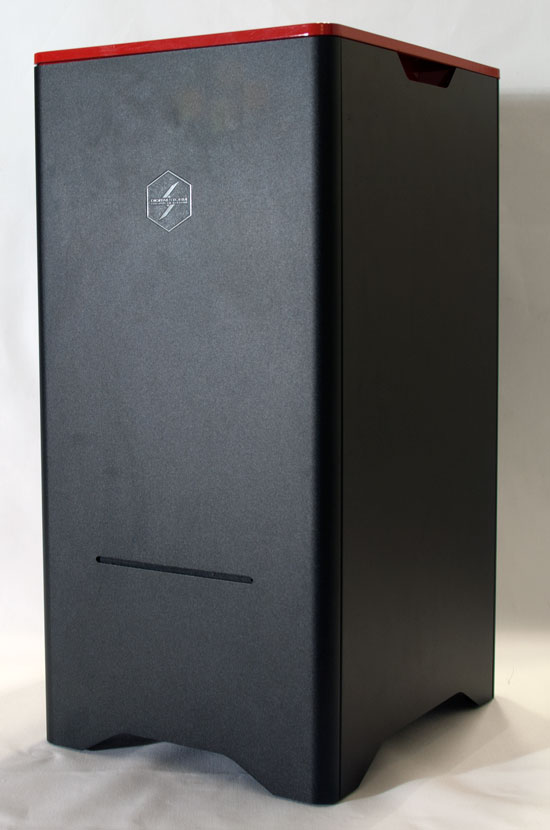
The red trim and black shell do a lot of favors for SilverStone's FT03 enclosure, but we're really interested in how well the Enix sings. Our last visit with DigitalStorm was a mixed one: the BlackOps Assassin we reviewed was a performance demon to be sure, but we were a bit turned off by some of the component choices coupled with the price tag. When we received the press release for the Enix, it was just too good to resist, and DigitalStorm was game to send us one. So how much power is crammed into this little box?
| DigitalStorm Enix Specifications | |
| Chassis | SilverStone FT03 (custom paint) |
| Processor |
Intel Core i7-2600K @ 4.7GHz (spec: 4x3.4GHz, 32nm, 8MB L3, 95W) |
| Motherboard | ASUS P8P67-M Pro Motherboard with P67 chipset |
| Memory | 2x4GB Corsair Dominator DHX DDR3-1600 (expandable to 16GB) |
| Graphics |
2x EVGA GeForce GTX 580 1.5GB GDDR5 (512 CUDA Cores, 772/1544/1002MHz Core/Shaders/RAM, 384-bit memory bus) |
| Hard Drive(s) |
Corsair Performance 3 128GB SATA 6Gbps SSD Western Digital Caviar Black 1TB SATA 6Gbps HDD |
| Optical Drive(s) | Optiarc BD-ROM/DVD+-RW Slimline Combo Drive |
| Networking | Realtek PCIe Gigabit Ethernet |
| Audio |
Realtek ALC892 HD Audio Speaker, mic, line-in, and surround jacks for 7.1 sound Optical out |
| Front Side | Optical drive |
| Top |
2x USB 3.0 2x PS/2 Optical out 6x USB 2.0 eSATA Ethernet Speaker, mic, line-in, and surround jacks for 7.1 sound 4x DVI-D 2x Mini-HDMI |
| Back Side | - |
| Operating System | Windows 7 Home Premium 64-bit |
| Dimensions | 11.18" x 9.25" x 19.17" |
| Weight | 14.77 lbs (case only) |
| Extras |
SilverStone Strider Gold 1000W PSU 80 Plus Gold Certified Corsair H70 Liquid Cooler Case Paint |
| Warranty | 3-year limited warranty with life-time customer care |
| Pricing |
Enix starts at $1,149 As configured $3,612 |
We start out with both the DigitalStorm Enix's curse and its saving grace: a heavily souped-up Intel Core i7-2600K water-cooled using Corsair's H70 kit (a testament to both the kit's performance and the FT03's surprisingly roomy interior). DigitalStorm has overclocked the i7-2600K to a screaming 4.7GHz, making it not only the fastest processor we've ever tested in a boutique system but also among the most power hungry as you'll see later.
As if to reassure everyone that splitting the i7-2600K's sixteen PCI-Express 2.0 lanes between two cards isn't really a big deal, DigitalStorm has packed the Enix with two EVGA GeForce GTX 580s running at stock speeds in SLI. If every single frame matters to you, then the P67 chipset and inherent limitations of using the processor's PCIe lanes may put you off, but between the variability in performance of running a multi-GPU setup and the absurdly high performance of two GTX 580s in SLI paired with an overclocked i7-2600K, it's hard for anyone to reasonably take issue.
Based on our last experience with DigitalStorm, they've also opted to use a higher-end name-brand memory kit and power supply. This was a source of some contention in the comments of that review, where some readers argued that if the memory works, it works, and there's no need to ding the vendor for using cheaper stuff. That's true, but at the same time, if I'm paying over $3,000 for a desktop I'm going to want parts from vendors that have a history of reliability, and there's something miserly about putting discount memory in a premium gaming machine.
To round out the system, DigitalStorm bumped the slot-loading optical drive up to a Blu-ray reader/DVD-writer, added the requisite 1TB Western Digital Caviar Black, and then chose to employ the new Corsair Performance 3 SSD.
All told, the Enix looks to be, at least on paper, the fastest system we've ever tested (a dubious honor when a new contender is always just around the corner). Ready to break some of our system benchmark records?
Application and Futuremark Performance
Given this is the fastest i7-2600K we've tested, one of the fastest graphics configurations on the market, and one of the fastest SSDs available, it's not unreasonable to expect the Enix we have on hand will top every one of our performance tests.
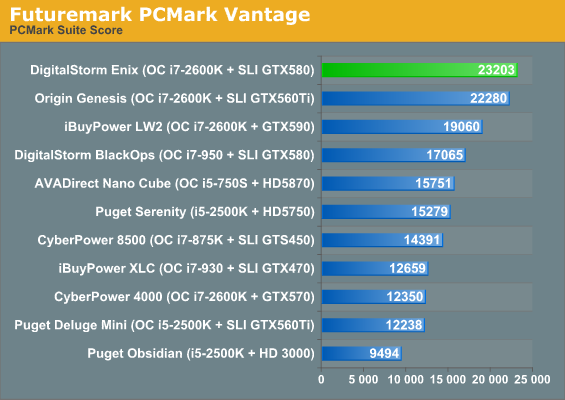
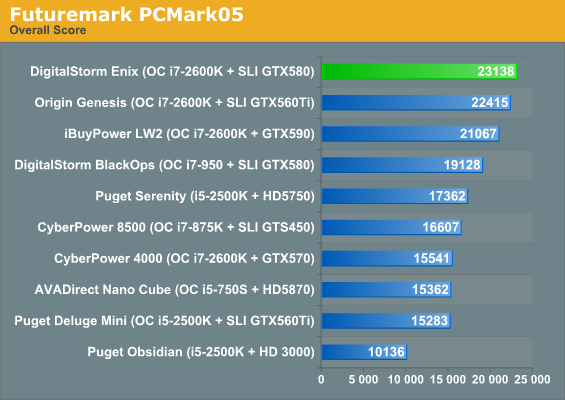
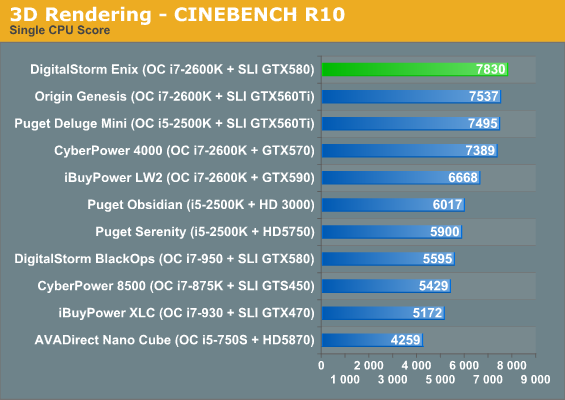
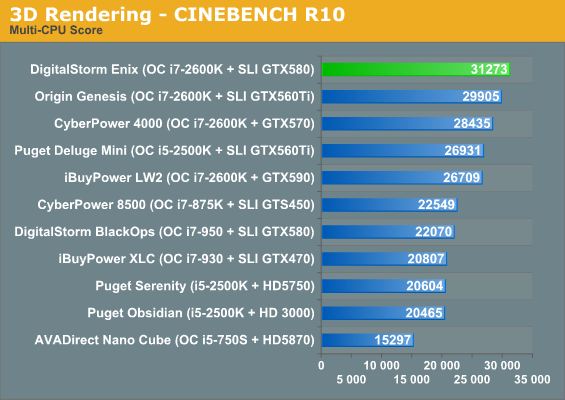
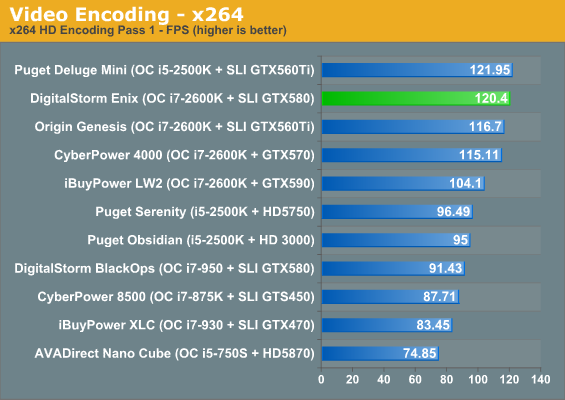
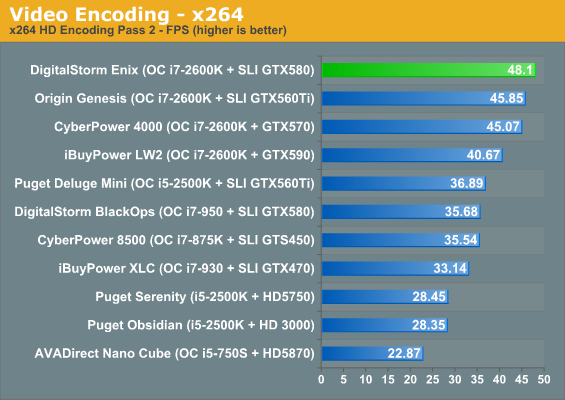
Apart from a minor hiccup in the first pass of our x264 encoding suite (close to being within the margin of error), the Enix shows up pretty much everywhere you'd expect it to be: the top of each chart. 3DMark should be no less kind.
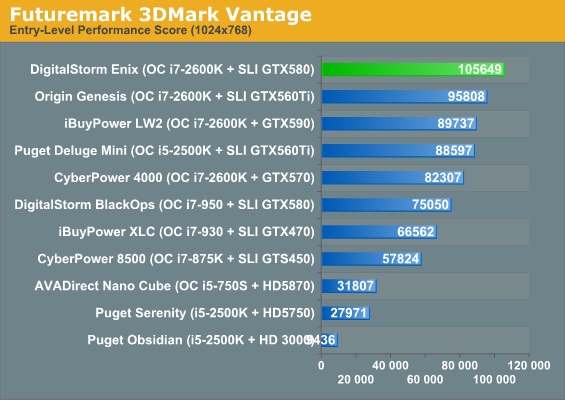
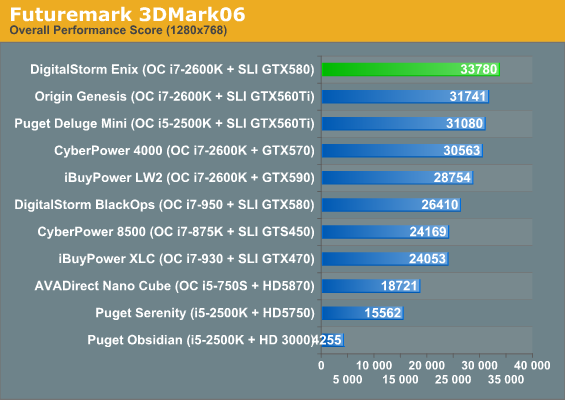
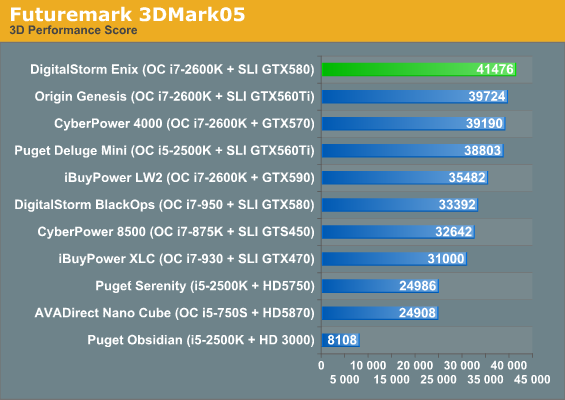
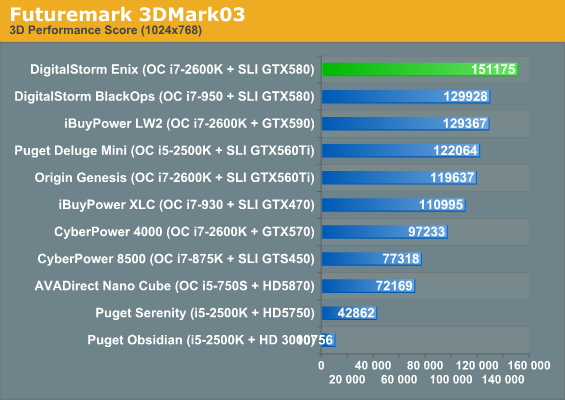
Yeah, it's more or less a bloodbath. The Enix's massive overclock and SLI NVIDIA GeForce GTX 580s take on all comers. But you already knew this was going to be the fastest machine we've yet tested, so the next page chock full of gaming benchmarks should be purely academic, right?
Gaming Performance
The last time we had a pair of GeForce GTX 580s on hand running in SLI was from DigitalStorm, but with the advent of Sandy Bridge that setup found itself surprisingly CPU-limited in some cases. With an overclocked i7-2600K backing them up now, the Enix should have no trouble cleaning house. We'll start with our "high" preset, which tends to be the most CPU-limited when dealing with massively powerful boutique gaming machines.
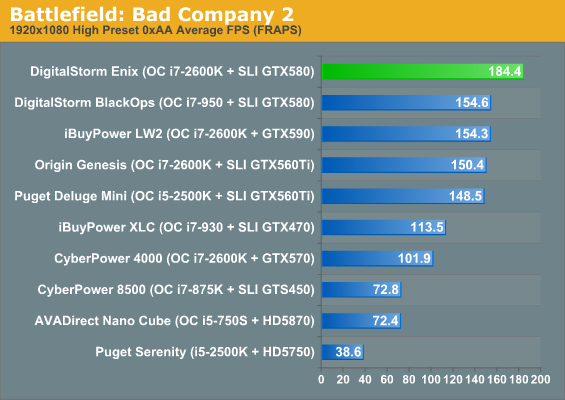
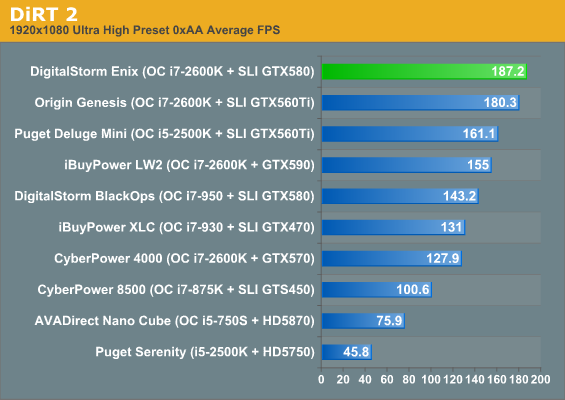
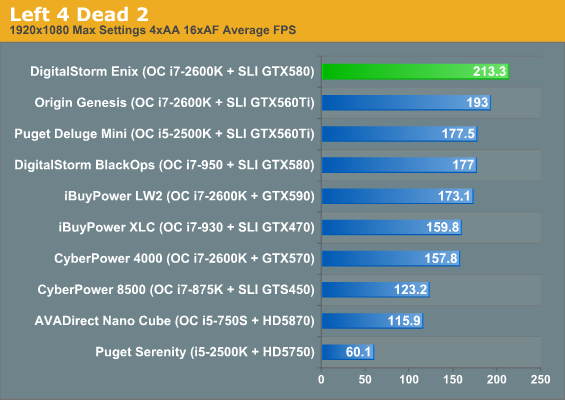
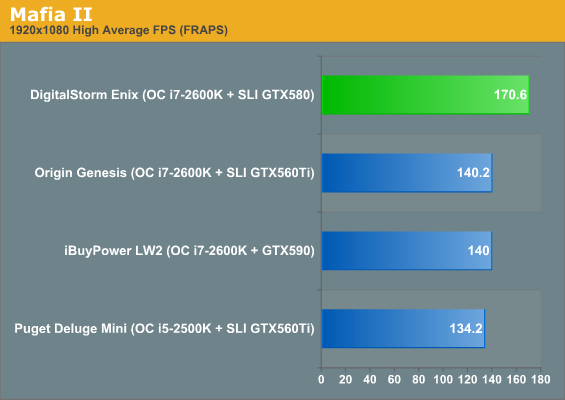
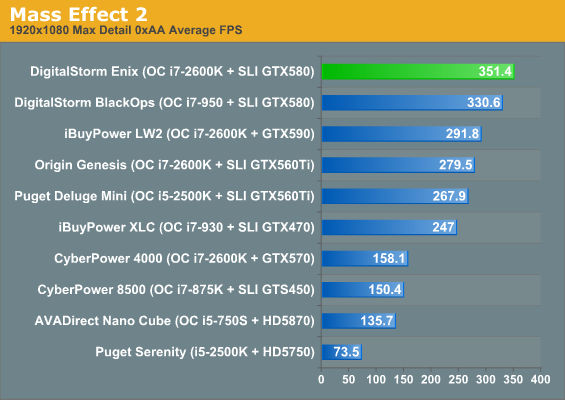
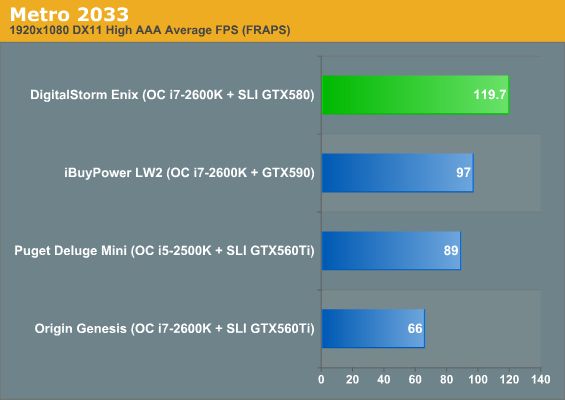
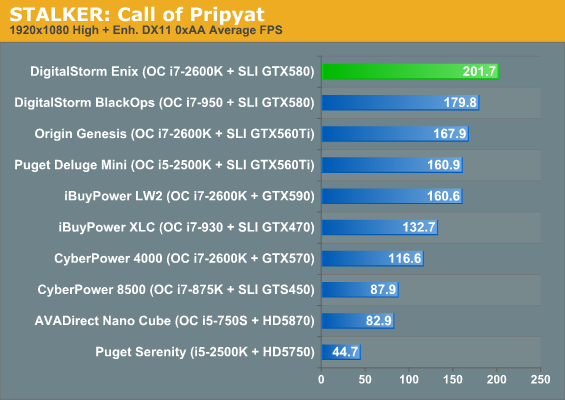
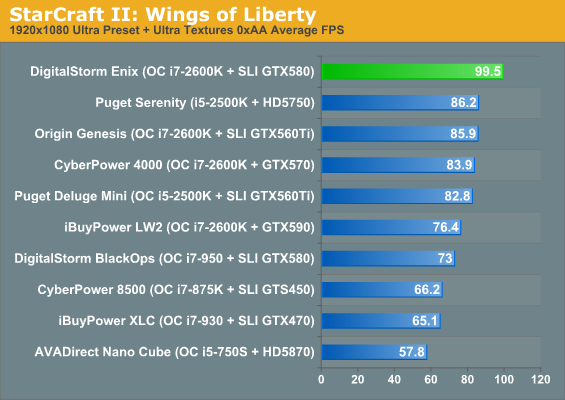
Expect this trend to continue. StarCraft II is the only game not to pull 100fps or better, and even that's within striking distance. A minor overclock on the graphics cards should be enough to push it over. Now see what happens when we add antialiasing to the equation with our "ultra" benchmark suite.
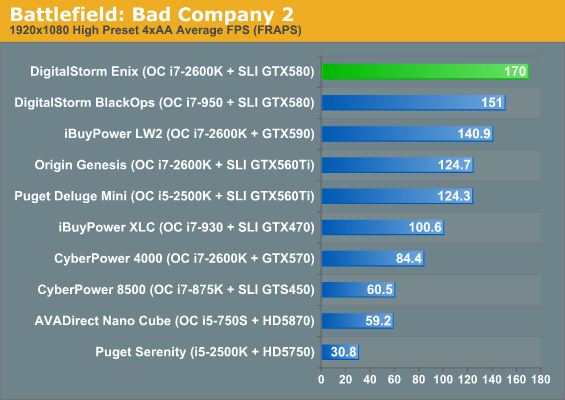
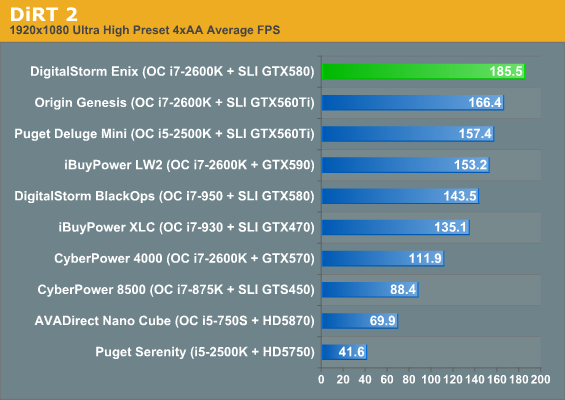
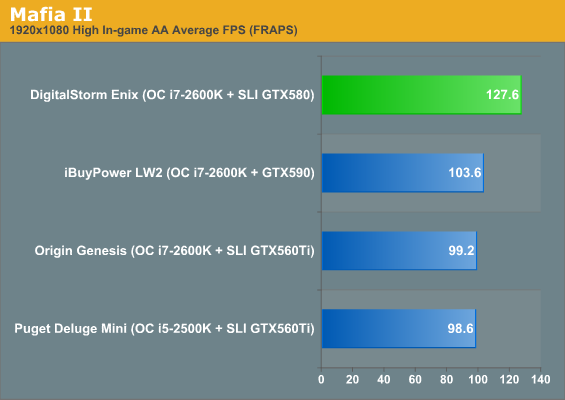
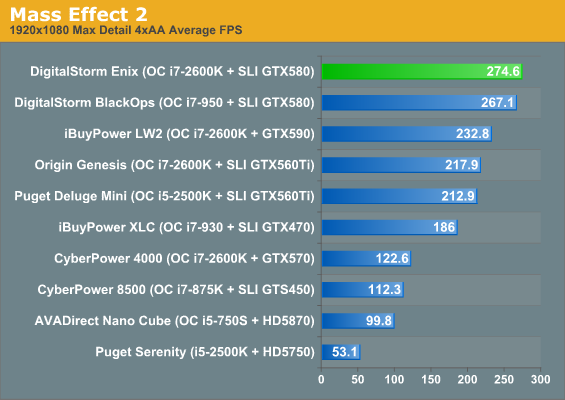
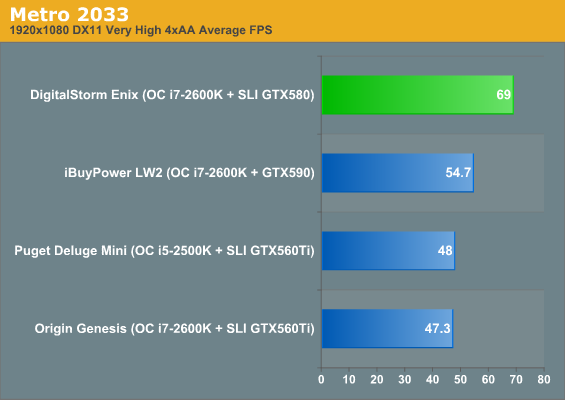
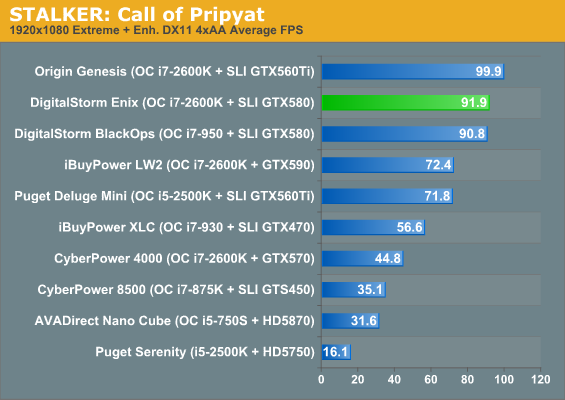
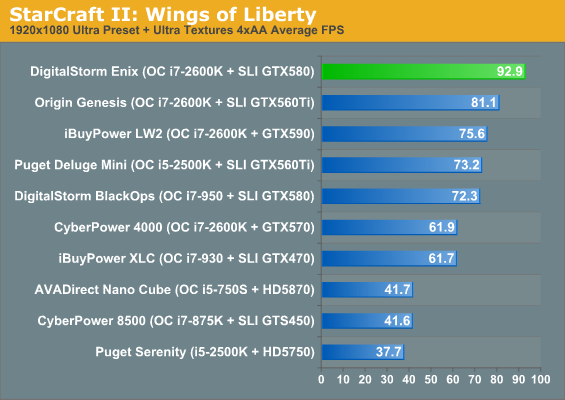
Inexplicably, Origin's Genesis with its much weaker graphics subsystem still manages to steal a win in STALKER, but those results were abnormal even when we recorded them. In all other cases, though, the Enix maintains a healthy lead over the other systems we tested.
Nobody buys $1,200 worth of video cards alone just to run them at 1920x1080, though. To put the proper amount of stress on this graphics subsystem, we've added benchmark results of the Enix running at 5760x1200. At this point it's worth mentioning that whatever quirks NVIDIA had with their Surround implementation seem to have been worked out with the 270 series drivers; we had no issues getting the Enix up and running in Surround.
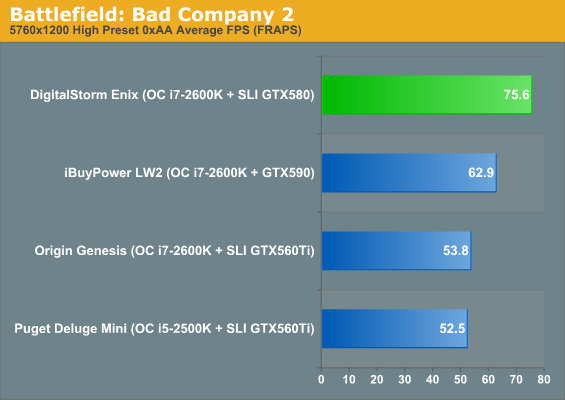
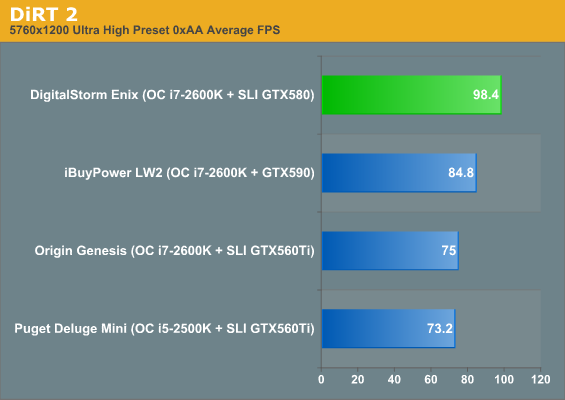
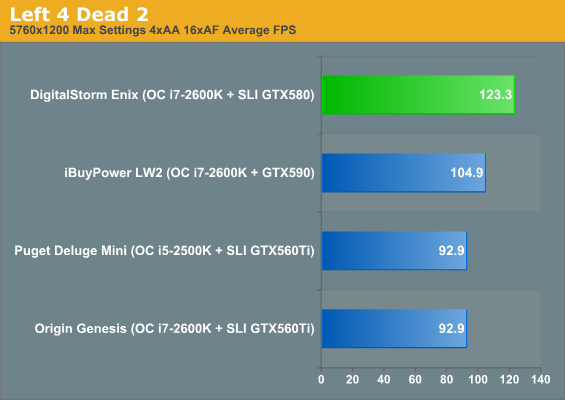
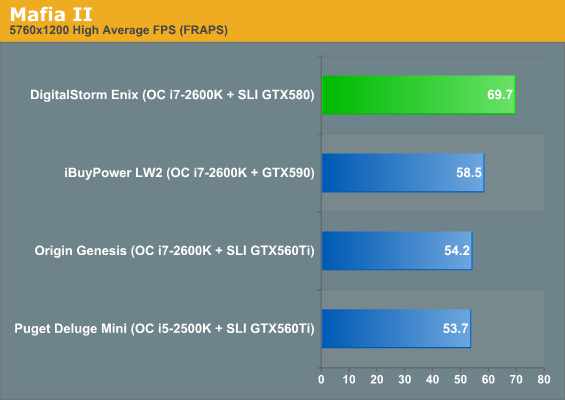
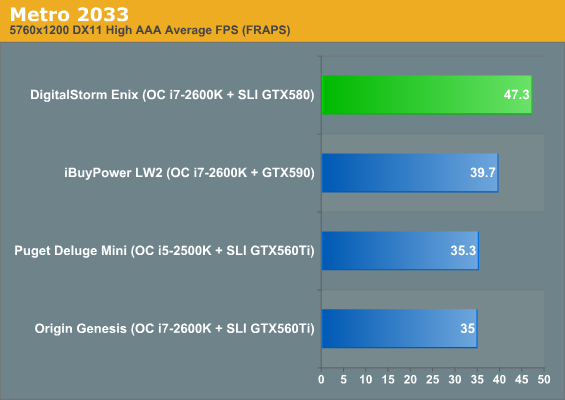
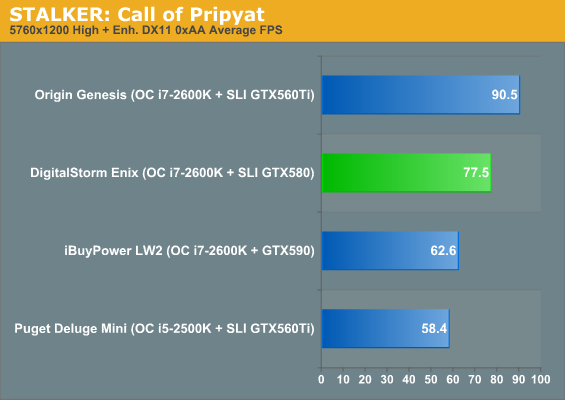
Discounting the again abnormal results of the Origin Genesis, the Enix pretty much reigns at the top of its game in each test, offering excellent performance even in the notoriously punishing Metro 2033. If you're interested in multi-monitor gaming, the Enix configured with SLI GTX 580's is definitely one way to get there. Naturally, the same hold for any other vendor using SLI 580 cards with an overclocked 2600K CPU, but we have to credit DigitalStorm for showing what is possible.
Build, Noise, Heat, and Power Consumption
Given the SilverStone FT03's essentially compact frame but excellent thermal qualities (particularly for blower-style graphics hardware), it would be easy to pin a lot of the DigitalStorm Enix's success on SilverStone's engineering. But as we've seen with the different boutiques, which chassis to use for which build is still a choice specific to that boutique, and DigitalStorm's choice to use SilverStone Fortress series enclosures for both of their review units speaks highly of them. This is an important decision and we're pleased to see no corners were cut.
That said, our experience with SilverStone's enclosures is that their stock configurations seem almost designed expressly for fine-tuning by the end user. While the red trim added to the plastic grilles of the FT03 is a nice touch, it doesn't take away from the fact that DigitalStorm could've done a bit more with this enclosure. They offer fine-tuning and even replacement of the fans in the FT03, and that would've been appreciated in our review unit as the stock fans in the FT03 can be a bit noisy--effective, yes, but still noisy. This case can do better and should in the hands of a custom builder.
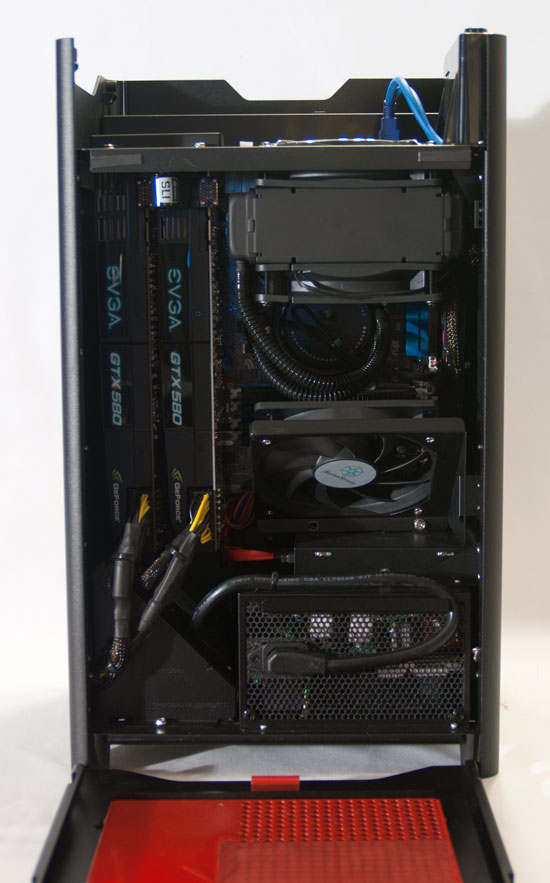
As you can see, the inside of the FT03 is pretty packed due in no small part to the massive pair of graphics cards and the equally substantial Corsair H70 water-cooling rig. The H70 proves to be remarkably effective at dissipating heat in this enclosure, but I found something troubling when I monitored heat and voltage. Check out these thermals:
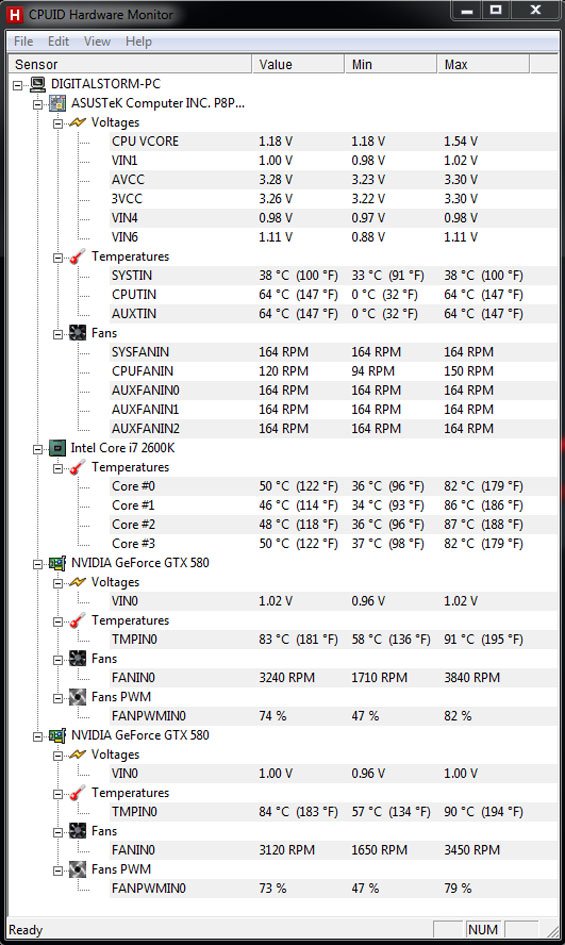
The high temperatures on the GTX 580s are still well within spec for those cards, but look at the core temperatures on the i7-2600K and then take a look at the Vcore. We've noticed in testing that when the system boots up, there's a large spike in the Vcore up to 1.52-1.54V, which is disturbingly high. This spike does level off after about a minute, and in stress testing with Prime95 the voltage peaks at a less troubling 1.48V.
Of course, that's still incredibly high for a 32nm processor, and high enough to give me pause about the processor's continued stability and lifespan at this overclock and voltage. DigitalStorm's engineers did say this was about right for how they ship the processor and their warranty will cover it if it goes south, but that doesn't change the fact that this voltage seems far too high.
I had a reader email me and suggest that if I'm going to cite lazy overclocks in boutique systems, I should try overclocking the chips myself. I agree by half: I'm not going to try to push the chips any harder (especially since these vendors do make some money in charging for higher overclocks), but I can definitely see if I can get the voltage to run lower. A quick and dirty visit into the ASUS board's UEFI showed a +0.21V offset on the processor; I was able to reduce this to +0.06V and still achieve stability in a quick five-iteration Standard run of IntelBurnTest. This isn't a rock solid stability test, but I was able to increment down far enough that conceivably within the 0.15V range I tested in there's a 24/7 stable setting. I'm still certain I probably could've gone lower on the offset, but my point is essentially made: this could've been tuned a lot better. Just my reduction in voltage brought load temperatures down 10C on the processor cores.
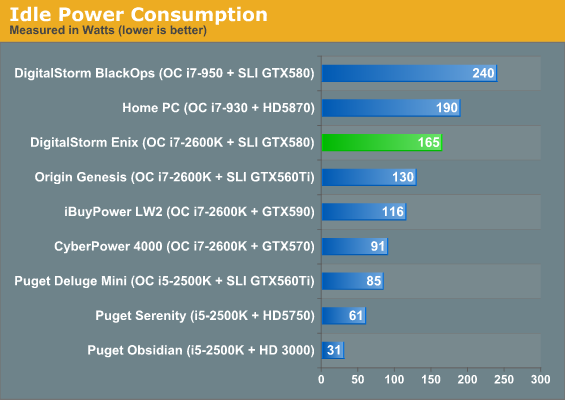
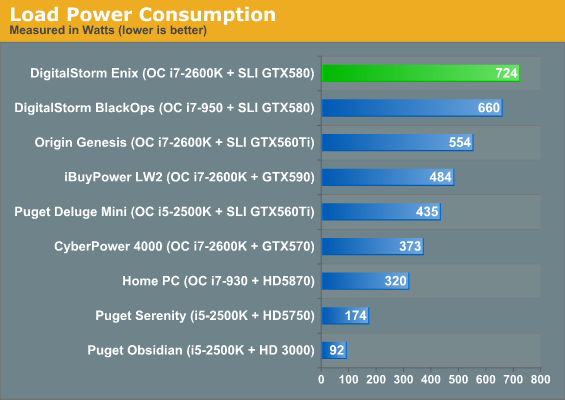
And the high voltage on the i7-2600K takes its pound of flesh. At stock speeds the i7 and pair of GTX 580s have a combined TDP of 583 watts. When load tested in Mafia II (which hammers both the processor and graphics subsystems surprisingly hard), the Enix consumes a staggering 724 watts. Raising the Vcore as much as DigitalStorm did can dramatically increase power consumption, and that seems to be exactly what's happening here. Even the i7-950 in their BlackOps wasn't overvolted this far (though it also isn't nearly this fast).
DigitalStorm's Take
I got in touch with DigitalStorm to discuss my concerns about the processor voltage, and after a bit of back and forth and discussion with Anand, we felt it would be best to include a statement from them:
Dear Dustin Sklavos,
Thank you for taking the time to recently review our Enix gaming system. We greatly appreciate your thorough attention to detail and are very interested in the voltage concern that you discovered while stressing the CPU.
After further testing at our facility, we were able to lower the offset voltage slightly while maintaining stability, but we quickly hit a stability wall while running our stress-test suite of LinX (AVX binaries with SP1) and Prime95. The Asus P8P67-M Pro does not have fine value adjustments for CPU Vcore, load line calibration, PLL overvoltage, phase control, and duty control. Without the option to enter exact values on these adjustments, a higher CPU offset voltage was needed in order to successfully pass our stress-test suite.
From our experience, the constant load voltage range of 1.45V to 1.48V from a Prime95 CPU burn-in test on the Enix at 4.7Ghz is an ideal range for the long term stability and performance of a system that is overclocked to almost 5GHz. In the past, when we’ve tried to use the absolute bare voltage necessary to achieve stability, a processor overclocked to 4.7GHz+ may become unstable after a month or two. Taking that into consideration, we want to ensure our customers receive a long-term stable system. The Enix is also configured to only supply that much voltage under the most extreme stress conditions. Under normal web browsing or gaming, a system will never experience the same stress conditions.
In addition, to ensure all of our current Enix customers are protected, we are automatically extending warranty coverage for any CPU related issues for up to 10 years from the date of purchase.
I am glad to hear that our Enix passed all of your tests with flying colors and that there were no issues with the stability of the system. I appreciate your feedback as it is always helpful in improving the customer experience at Digital Storm.
Regards,
Rajeev Kuruppu
Product Development
And there you have it. While I still have my reservations, at the very least DigitalStorm is willing to stand behind the overclocks on their Enix line and I'm not sure how much more we can really ask. Overclocking enthusiasts should be well aware of the long-term stability issues that frequently crop up, and as they point out they felt a bit more voltage would be best over the long haul. If you're comfortable doing the tweaking on your own, that's fine, but for a vendor that doesn't want to see flaky system returns after a few months we understand their approach.
Conclusion: Too Hot to Handle
If we take the contentious processor voltage issues off the table, what we're left with is a remarkably powerful machine in a tiny enclosure. That's a testament to all parties involved: SilverStone's engineers for producing a case this size that can support a pair of NVIDIA GeForce GTX 580s, Intel's engineers for producing in Sandy Bridge a processor with a tremendously high overclock ceiling, and DigitalStorm's engineers for smartly assembling a system with these components that maximizes performance while being able to handle, however delicately, the incredible amount of power and heat generated by them.
That voltage is a bone of contention, though, that we really have to leave up to you, the reader. Common wisdom from browsing forums and looking at what other overclockers are doing suggests that 1.45-1.48V on the processor core is too high for long-term use, while DigitalStorm's engineers state that this is ideal for maintaining an overclock of this magnitude on a Sandy Bridge chip. Anand and I both felt that it was too high, but we don't have the data to really back that up (though DigitalStorm would have a hard time doing the same: Sandy Bridge has only been out for a few months, nowhere near long enough to produce long-term reliability data). But DigitalStorm is willing to warranty the unit for three years standard and stand behind their overclock for ten years, well beyond the useful life of an enthusiast processor. That's the best one can ask for.
Ultimately the Enix is in many ways an improvement over the last unit we reviewed from DigitalStorm, their BlackOps Assassin Edition. Using the SilverStone FT03, they're able to increase performance over that behemoth while cutting the form factor by nearly two-thirds. Noise levels and power consumption have gone up a bit, but performance is up with them. The Enix is the fastest machine we've tested yet and DigitalStorm's people seem genuinely interested in producing quality kit and backing it up with quality service. Given our point of contention, it would be difficult to recommend an award for the Enix, but if you're willing to take the risk—and DigitalStorm is—this tower could be a great choice for someone who wants a unique and powerful desktop machine.













